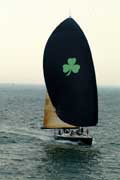Way Downstream
In Prince George’s County last week, a herd of Democrats came out to praise Rep. Steny Hoyer on the occasion of his 66th birthday and 25th bull roast. But when long-time Hoyer pal Terry Devaney took the stage, it seemed that Hoyer was the one being roasted. Devaney recalled that when playing basketball with Hoyer years ago, “It was the kind of game where only one guy took the shots — Steny Hoyer.” Hoyer must have been a ball hog playing football, too. “Steny couldn’t figure out how to pass to himself and catch it,” Devaney said …
From St. Mary’s County, evidence of the risk waterman take to work the water. Mark Jefferies lost his life after his boat overturned near the Wicomico River while he was crabbing. A day later, specially trained dogs from the Southern Maryland Canine Search and Rescue Unit found his body …
 In Washington, D.C., the National Trust for Historic Preservation last week put a 175-mile corridor from Gettysburg in Pennsylvania to Monticello in Virginia on its list of most endangered historic places because of relentless development that threatens the integrity of Civil War battlefields and presidential homes. Trust president Richard Moe, who has been profiled in these pages, told The Washington Post that his organization sees “more significant history in this corridor than in any comparable space in America”…
In Washington, D.C., the National Trust for Historic Preservation last week put a 175-mile corridor from Gettysburg in Pennsylvania to Monticello in Virginia on its list of most endangered historic places because of relentless development that threatens the integrity of Civil War battlefields and presidential homes. Trust president Richard Moe, who has been profiled in these pages, told The Washington Post that his organization sees “more significant history in this corridor than in any comparable space in America”…
In Newport, Rhode Island, the first yacht crossed the finish line in the Annapolis to Newport Race 53 hours, nine minutes, 26 seconds after leaving Annapolis June 10 (“Heart, Sea Legs and Half a Million Dollars,” Vol. xiii, No 23: June 9). The yacht was Annapolitan Jim Muldoon’s custom 72-footer Donnybrook, a four-time winner in the historic race …
Our Creature Feature comes from a nest alongside northern waters, where a National Wildlife Federation web camera is recording the drama of nesting loons. Loons, known for their haunting, distinctive trill, returned to the same nest they have used in the past, and the female laid her eggs May 27.
Already, they have driven off a hungry mink as they protect eggs that are expected to hatch around June 24. The federation is using its camera to emphasize threats from mercury and other pollution that are diminishing loon populations. Watch for yourself at http://nwf.m0.net/m/s.asp?HB20218093575X4741373X625421.



 In Washington, D.C., the National Trust for Historic Preservation last week put a 175-mile corridor from Gettysburg in Pennsylvania to Monticello in Virginia on its list of most endangered historic places because of relentless development that threatens the integrity of Civil War battlefields and presidential homes. Trust president Richard Moe, who has been profiled in these pages, told The Washington Post that his organization sees “more significant history in this corridor than in any comparable space in America”…
In Washington, D.C., the National Trust for Historic Preservation last week put a 175-mile corridor from Gettysburg in Pennsylvania to Monticello in Virginia on its list of most endangered historic places because of relentless development that threatens the integrity of Civil War battlefields and presidential homes. Trust president Richard Moe, who has been profiled in these pages, told The Washington Post that his organization sees “more significant history in this corridor than in any comparable space in America”…